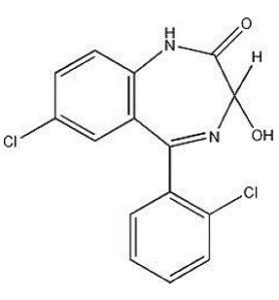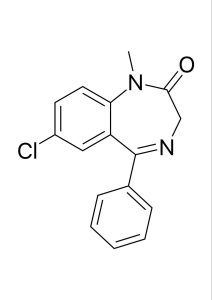What is better for pain and calming nerves: Ativan or Valium
All About Valium and Ativan
Valium and Ativan: Ativan is used for the treatment of anxiety, insomnia, or sleep difficulty due to anxiety or stress, status epilepticus (continuous seizures), and as a medication given right before anesthesia.
The generic name of Ativan is Lorazepam. Ativan (lorazepam) belongs to a group of drugs called benzodiazepines (ben-Zoe-dye-AZE-eh-peens). It is thought that lorazepam works by enhancing the activity of certain neurotransmitters in the brain.
It is an antianxiety agent. The chemical name of Ativan (lorazepam) is 7-chloro-5-(o-chlorophenyl)-1,3- dihydro-3-hydroxy-2H-1,4-benzodiazepine-2-one. The chemical formula is C15H10Cl2N2O2 and the molecular weight is 321.16.
The chemical structure of Ativan (lorazepam) is given below.
Chemical structure of Ativan (lorazepam)
Ativan (lorazepam) is a nearly white powder almost insoluble in water. Each Ativan (lorazepam) tablet, to be taken orally, contains 0.5 mg, 1 mg, or 2 mg of lorazepam. The inactive ingredients present are lactose monohydrate, magnesium stearate, microcrystalline cellulose, and polacrilin potassium.
Description of Valium (diazepam)
Valium 10mg is used to treat anxiety disorders and the symptoms of alcohol withdrawal. The generic name of Valium is diazepam. It is a benzodiazepine that enhances the activation of certain neurotransmitters in the brain. Valium is also used in conjunction with other drugs to treat muscular spasms and stiffness, as well as seizures.
The chemical name of Valium (diazepam) is 9-chloro-2-methyl-6-phenyl-2,5-diazabicyclo[5.4. 0]undeca-5,8,10,12-tetraen-3-one or 7-chloro-1,3-dihydro-1-methyl-5-phenyl-2H-1,4-benzodiazepin-2-one and the chemical formula is C16H13ClN2O with a molecular weight of 284.7 g/mol.
The chemical structure of diazepam (C16H13ClN2O) is given below.
Chemical structure of diazepam (C16H13ClN2O)
Properties of Valium and Ativan
Valium and Ativan medicines are both prescribed for pain and anxiety disorders. Both medicines are in the class of benzodiazepines. Both medicines are commonly used in the treatment of neural conditions of anxiety and depression.
They function by amplifying the effects of gamma-aminobutyric acid (GABA), a neurotransmitter that has been shown to reduce nerve overactivity. Valium is also used for seizure disorders, alcohol withdrawal symptoms, and muscular relaxation. Valium is a benzodiazepine with a fast start, whereas Xanax is a benzodiazepine with a slow onset.
All benzodiazepines, including Valium (diazepam) and Ativan (lorazepam), can exacerbate opioid-induced respiratory depression. When Valium (diazepam) or Ativan (lorazepam) is used alongside opioids like hydrocodone or morphine, significant respiratory depression and sedation can occur, leading to coma or death. If this combination is medically required, patients should be constantly watched and the combination should be administered for the minimal possible feasible.
Valium and Ativan have been widely used due to their impact on anxiety. Valium was discovered to be more effective in managing anxiety in one example, although the comparison between the two medicines may not be clinically complete. Both medicines are known to promote fatigue as well as slow response times and flexibility. Valium’s effects will take longer to go off because of its long 1/2-lifestyle, and this must be considered while considering therapy.
In addition to the above similarities, both medications are widely abused. They’re cost-effective and to get. People who misuse prescription pharmaceuticals like Xanax and Valium can obtain large quantities of the pills by obtaining many doctor’s prescriptions or illegally procuring them off the street.
According to the United States Drug Enforcement Administration, diazepam and alprazolam are frequently combined with methadone to boost the euphoric effects of both medications. Self-medicating symptoms of withdrawal or hangovers with benzodiazepines is a standard procedure among those addicted to other substances, such as cocaine.
Dosage comparison between Valium and Ativan:
Ativan 2mg (lorazepam) is applicable for the following disease.
- For treating Short term anxiety
- For treating Anxiety disorder
- Sleep disturbances that occur due to anxiety
- Sedation before surgery or dental procedures
- Alcohol Withdrawal Syndrome
The usual adult dosage for anxiety initiates with 2 to 3 mg orally 2 to 3 times a day. Maintenance dosage can be 1 to 2 mg orally 2 to 3 times a day.
Moreover, Geriatric dosage for anxiety for older or debilitated patients initiates with 1 to 2 mg orally in a day. The dosage should be given in a divided form.
Furthermore, the Usual pediatric dosage for anxiety for children 12 years or older initiates with 2 to 3 mg orally 2 to 3 times a day.
The following point needs to be taken care of while the course of the Ativan (lorazepam).
- The daily dosage may vary from 1 to 10 mg/day.
- The dosage should be increased gradually when needed to help avoid adverse effects.
- When a higher dosage is indicated, the evening dose should be increased before the daytime doses.
- The use of anxiolytic agents is typically not needed to treat anxiety/tension associated with the stress of everyday life.
- Clinical studies have not evaluated Ativan (lorazepam) for efficacy in long-term treatment greater than 4 months.
For Valium (diazepam),
Valium (diazepam) should only be used according to a doctor’s prescription. The typical adult dose is 2 to 10 mg taken orally 2 to 4 times per day. Furthermore, the intensity of the symptoms should be used to decide on the oral dose. Anxiety caused by ordinary stress, on the other hand, typically does not necessitate Valium 5 mg therapy.
For the first 24 hours, the usual adult dose for alcohol withdrawal is 10 mg orally 3 to 4 times a day. The maintenance dose for withdrawal is 5 mg orally 3–4 times per day, as required.
Adult dosage for adjunctive treatment for the relief of skeletal muscle spasm due to reflex spasm to local pathology, spasticity caused by upper motor neuron disorders, athetosis, and stiff-man syndrome (e.g., inflammation of the muscles/joints secondary to trauma, cerebral palsy, paraplegia) is 2 to 10 mg orally 3 to 4 times a day and Parenteral, 5 to 10 mg IM or IV, then 5 to 10 mg IM or IV in 3 to 4 hours if necessary.
Patients should avoid taking Valium if they are allergic to diazepam or have the following diseases.
- Myasthenia gravis is a disease that affects the muscles of the arms and legs (a muscle weakness disorder)
- A serious respiratory issue
- Sleep apnea is a condition in which a person stops breathing while sleeping (breathing stops during sleep)
- Glaucoma with a narrow-angle
- Open-angle glaucoma that is untreated or uncontrolled.
- Severe liver disease.
Conclusion: Valium and Ativan
Conclusively, it is clear that both medicines Valium and Ativan have similar natures and are almost similar effects on the disease of anxiety disorder, depression, and pain. However, diazepam and lorazepam differ in potency and in the time course of their action. Moreover, diazepam has an equivalent opioid nature compared to lorazepam.
Additionally, diazepam is better absorbed after oral administration than lorazepam. In addition, 10 mg of diazepam is equivalent to Lorazepam 2-2.5 mg, and Ativan (lorazepam) has fewer drug interactions than Valium (lorazepam). Thus it has been proven that Valium (Lorazepam) is more effective in the treatment of anxiety, depression, and pain than Ativan (lorazepam).
All benzodiazepines, including Valium (diazepam) and Ativan (lorazepam), can exacerbate opioid-induced respiratory depression. When Valium (diazepam) or Ativan (lorazepam) is used alongside opioids like hydrocodone or morphine, significant respiratory depression and sedation can occur, leading to coma or death. If this combination is medically required, patients should be constantly watched and the combination should be administered for the minimal possible feasible.


